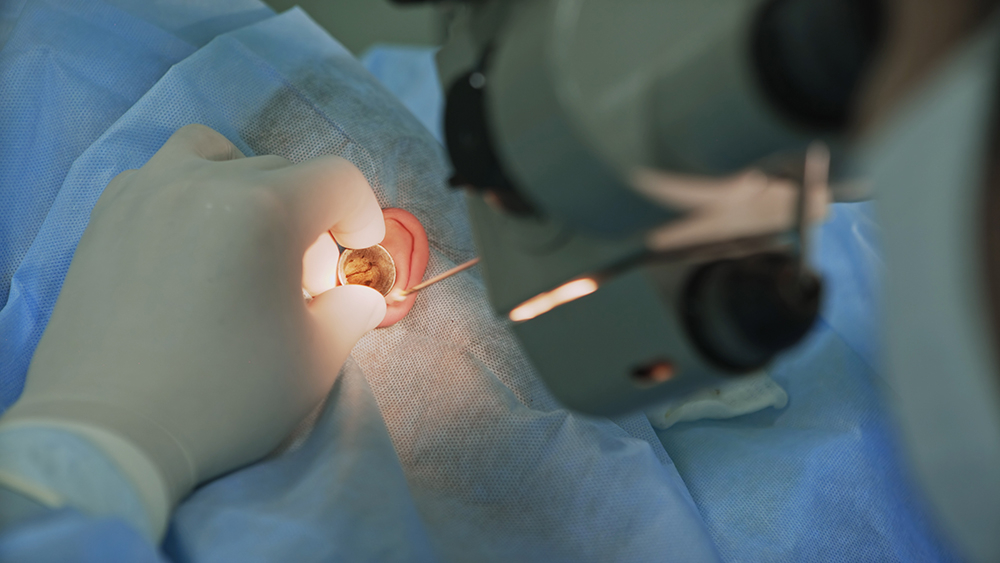
A Keck Medicine of USC expert explains how robotics are improving cochlear implant results for patients.
Thanks to robotic assistance, cochlear implants may become easier and safer to implant than ever before. In some cases, they could also improve the quality of hearing patients experience after cochlear implant surgery.
Seiji Shibata, MD, PhD, an otolaryngologist with the USC Caruso Department of Otolaryngology – Head and Neck Surgery, part of Keck Medicine of USC, discusses how this newly available technology is improving hearing outcomes for cochlear implant patients.
Cochlear implant surgery is a delicate procedure.
A cochlear implant is a small device that turns acoustic signals into electric signals which stimulate the auditory nerve and are then transmitted to the auditory cortex. During cochlear implant surgery, the physician inserts the electrodes of the cochlear implant into the patient’s inner ear, also known as the cochlea. Today, these electrodes are most often inserted through the inner ear’s round window, which is one of two openings of the inner ear. Inserting the electrodes through the round window became possible as electrode designs advanced and electrodes became smaller and more flexible.
Inserting the electrode through the round window is believed to be less likely to damage the fine structures of the inner ear, but the procedure still poses risks. Shibata explains how the process works.
“First, the surgeon drills some bone away to gain access to where the cochlear implant will be inserted. Once you gain access to the middle ear, you can see the round window membrane of the inner ear. A lot of surgeons now insert the electrodes through the round window membrane because there is less bone drilling involved and reduced risk of damaging the delicate parts of the inner ear such as the Organ of Corti or the basilar membrane.”
To ensure the inner ear isn’t damaged, electrodes must be inserted extremely slowly and precisely. Mastering this art takes a lot of experience.

“Some people even advocate taking five or six minutes for insertion alone,” Shibata says. “The round window opening is very small, and the electrode is flexible and floppy like a noodle. Imagine trying to thread a noodle through a small needle hole. That’s what the implant process is like.”
He continues: “Your hand might look like it’s stable and progressing at a very slow rate, but when you actually watch footage of the procedure, you can see the extra microscopic movements the surgeon’s hand makes. When you try to move or advance the electrode, the hand moves up and down — and that micro-movement is enough to cause damage to the inside of the cochlea or even cause a translocation of the basilar membrane.”
Such micro-trauma can cause fibrosis that can result in hearing loss months or even years after implant surgery.
Enter robotic assistance
Instead of manually implanting the cochlear implant, a select number of experts, such as those at the USC Caruso Department of Otolaryngology – Head and Neck Surgery, are now able to perform robotic-assisted cochlear implant surgery. With the help of robotics, surgeons can increase the steadiness of electrode insertion and reduce the speed of insertion.
The bulk of the cochlear implant procedure is still performed manually by the surgeon. “About 95% of the surgery is done by hand,” Shibata says. “It’s just during the 5% of the procedure when the electrodes are inserted when we can now use a motor that advances the electrodes into the cochlea.”
“The motor allows you to advance the electrodes at different speeds,” he continues, “and it advances at a very steady speed. The surgeon can choose the speed. Most recently when using it, I inserted an electrode at a rate of 0.2 millimeters per second. You can’t replicate a rate that slow by hand. It’s impossible. It’s much steadier compared to the human hand.”
Shibata says robotic-assisted cochlear implant surgery has the potential to improve overall outcomes. “It reduces the trauma that can be caused by manual insertion,” he says. “One study I co-authored as a neurotology fellow at the University of Iowa Hospitals and Clinics showed that robotic insertion reduces the insertional intracochlear trauma compared to manual insertion in cadaveric tissue, even when performed by expert otology/neurotology surgeons across the nation.”
By minimizing damage to the inner ear, robotic-assisted cochlear implant surgery can help patients preserve their residual hearing. Part of preserving sound quality requires not risking additional damage to the inner ear structures during surgery.
For instance, Shibata says, older patients commonly experience high-frequency hearing loss yet maintain low-frequency hearing. Their ability to hear in noisy environments or to hear music may be diminished. In the past, these patients were not candidates for cochlear implants because of the damage to inner ear structures and loss of low-frequency hearing. A cochlear implant, when using a soft insertion technique, can preserve low-frequency hearing and enhance performance, giving patients the ability to appreciate complex tones such as music and hear in noisy environments.
“The benefits of robotic-assisted cochlear implant surgery are especially significant for patients who still have some residual hearing,” Shibata adds. “The controlled and steady insertion by the robotic-assisted device can help reduce trauma and maintain residual hearing of the lower frequencies. The patient can still enjoy a lot of complex sounds like music and hear in noisy surroundings.”
Patients can also get back on the road to hearing quicker and easier after receiving a cochlear implant. “Preserving residual hearing means you might be able to adapt to the cochlear implant faster and easier while still maintaining your natural hearing,” he says. “You might not have to do as much rehabilitation. It helps with your overall hearing outcomes after getting a cochlear implant.”
A promising future
Surgeons learning to perform robotic-assisted cochlear implant surgery may want to keep a few things in mind, Shibata says. “It’s mostly getting used to the angles during insertion and making sure you make a large enough incision behind the ear and a wide enough opening to the middle ear,” he says. “You might be able to get away with making a smaller incision and opening when inserting an implant by hand, but when using the robot, you need an adequate-sized opening.”
Overall, however, “I think it’s a technology that can help improve cochlear implant outcomes. Robotic assistance could help preserve more hearing long-term.”
Topics
